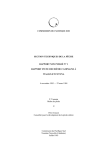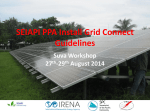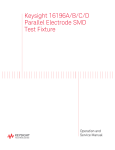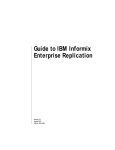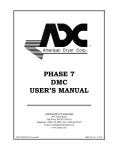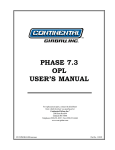Download GRID-CONNECTED PV SYSTEMS
Transcript
GRID-CONNECTED PV SYSTEMS (No Battery Storage) SYSTEM INSTALLATION GUIDELINES FOR THE PACIFIC ISLANDS GRID-CONNECTED PV SYSTEMS • SYSTEM INSTALLATION GUIDELINES | a GRID-CONNECTED PV SYSTEMS (No Battery Storage) SYSTEM INSTALLATION GUIDELINES FOR THE PACIFIC ISLANDS These guidelines have been developed by the Sustainable Energy Industry Association of the Pacific Islands in Collaboration with the Pacific Power Association They represent latest industry BEST PRACTICE for the design and installation of PV Grid Connect Systems. © Copyright 2012 www.ppa.org.fj • www.seiapi.org While all care has been taken to ensure this guideline is free from omission and error, no responsibility can be taken for the use of this information in the installation or design of any grid connect system. GENERAL The performance of a reliable installation that fulfils a customer’s expectations requires both careful design and correct installation practice. Compliance with relevant Health and Safety regulations is necessary. STANDARDS for INSTALLATION System designs should follow any standards that are typically applied in the country or region where the solar installation will occur. The following are the relevant standards in Australia, New Zealand and USA. Some Pacific island countries and territories do follow those standards. These standards are often updated and amended so the latest version should always be applied. In Australia and New Zealand the following standards are applicable: … ̶ AS/NZS 3000 Wiring Rules ̶ AS 4777.1 Grid connect - Installation ̶ AS/NZS 5033 Installation of Photovoltaic (PV) Arrays ̶ AS/NZS 1768 Lightning Protection ̶ AS/NZS 4509 Stand-alone Power Systems ̶ AS/NZS 3008 Selection of cables ̶ AS/NZS 1170.2 Wind Loads In USA PV systems must be in accordance with following codes and standards: ̶ Electrical Codes-National Electrical Code Article 690:Solar Photovoltaic Systems and NFPA 70 Uniform Solar Energy Code ̶ Building Codes- ICC, ASCE 7 ̶ UL Standard 1701; Flat Plat Photovoltaic Modules and Panels ̶ IEEE 1547, Standards for Interconnecting distributed Resources with Electric Power Systems ̶ UL Standard 1741 , Standard for Inverter, converters, Controllers and Interconnection System Equipment for use with Distributed Energy Resources In the Australian standards Low Voltage (LV) is defined as 120V d.c. and above and Extra Low Voltage (ELV) is defined as below 120V d.c. In the USA standard anything above 60V d.c. is considered dangerous. Typically all grid connect PV arrays are above 120V d.c and hence considered LV. LV is dangerous and can kill a person if they come into contact with live terminals. DOCUMENTATION All complex systems require a user manual for the customer. Grid-connected PV systems are no different. The documentation for system installation that must be provided is … • List of equipment supplied. • Shutdown and isolation procedure for emergency and maintenance. • Maintenance procedure and timetable. • Commissioning sheet and installation checklist. • Warranty information. • System connection diagram (as installed). • System performance estimate • Equipment manufacturers documentation • Array frame engineering certificate • Array frame installation declaration and • Handbooks for all equipment supplied. GRID-CONNECTED PV SYSTEMS • SYSTEM INSTALLATION GUIDELINES | 1 PV MODULES PV modules shall comply with the requirements of IEC 61730-1 and IEC 61730-2, or EN 61730-1 and EN 61730-2, or UL Standard 1703. PV ARRAY ORIENTATION AND TILT In grid connected PV systems the solar array is generally mounted: • • • “Flat” on the roof (that is parallel to the slope of the roof ) OR Integrated into the building OR On an array frame that is tilted to fix the array at a preferred angle (usually for flat roofs or ground mounted). Modules that are electrically in the same string must be all in the same orientation. For best year-round performance a fixed PV array should be mounted facing true north (± 10°) in South Pacific and true south (± 10°) in North Pacific at an inclination equal to the latitude angle or at an angle that will produce the best annual average performance taking into consideration: seasonal cloud patterns, local shading and environmental factors. In the tropics this could vary due to the sun being both north and south at different times of the year. Note: A minimum tilt of 10° is recommended to take advantage of self-cleaning during rain periods. Horizontally mounted arrays will require additional maintenance [cleaning]. Between latitudes 10° South and 10°North the array should be tilted at a minimum of 10 degrees. If the array is “flat” on the roof (that is parallel to the slope of the roof ) or integrated into the building fabric, true NORTH true SOUTH PV Module LATITUDE ANGLE e.g. for PALUA ( Lat 7° ) PV Module LATITUDE ANGLE e.g. for SUVA ( Lat 18° S ) The tilt angle should be approximately 18° The tilt angle should be approximately 7°. However because of the cloud cover in the wet season a tilt angle of 20° would be better. This would result in a greater energy output from the array in the dry season. Figure 1 a Figure 1 b the array will often not be at the preferred (optimum) tilt angle and in many situations will not be facing due north or due south. 2 | GRID-CONNECTED PV SYSTEMS • SYSTEM INSTALLATION GUIDELINES Included with the design guide is a set of tables for the following locations: • Suva, Fiji (Latitude 18°08’S Longitude 178°25’E) • Apia, Samoa (Latitude 13o50’ S’ Longitude 171o44’ W) • Port Vila, Vanuatu (Latitude 17° 44’ S Longitude 168° 19’ E) • Tarawa, Kiribati (Latitude 1°28’N, Longitude 173°2’E) • Raratonga, Cook islands( Latitude 21°30’S, Longitude 160°0’W) • Nuku’alofa, Tonga (Latitude 21º14’S Longitude 175º22’W) • Honiara, Solomon Islands (Latitude 09°27’S, Longitude 159°57’E) • Koror, Palau ( Latitude 7°20’N Longitude 134°28’E) • Palikiri, Pohnpei FSM (Latitude: 6°54’N, Longitude: 158°13’E) • Majuro, Marshall Islands (Latitude: 7º 12N, Longitude 171º 06E) • Alofi, Niue (Latitude 19°04’ S. Longitude 169° 55’ W) • Nauru (Latitude 0º55’S, Longitude 166º 91’E) • Tuvalu (Latitude 8°31’S, Longitude 179°13’E) • Hagåtña, Guam (Latitude 13°28’N Longitude: 144°45’E) • Noumea, New Caledonia (Latitude 22°16’S Longitude: 166°27’E) • Pago Pago, American Samoa (Latitude 14°16’ S Longitude: 170°42’W) These tables show the average daily total irradiation for each month of the year for: surface at horizontal, a surface tilted at latitude and for a surface tilted at latitude plus 15 degrees. Also included in the design guidelines is a table derived from the Australian Solar Radiation Data Handbook. This table is for Cairns, a coastal city located in the tropics. Hence the figures in the table would be similar to that for some cities/islands within the Pacific Island countries because it reflects the variation in irradiation due to different tilts and azimuths from that measured and recorded at horizontal. The table shows the average daily total irradiation represented as a percentage of the maximum value i.e. PV orientation is true North (azimuth = 0° ) with an inclination equal to the latitude angle. The table provides values for a plane in 36 orientations (azimuths) and 10 inclination (tilt) angles. [Increments of 10o ] . Using the table from Australia will provide the system designer/installer with information on the expected output of a system (with respect to the maximum possible output) when it is located on a roof that is not facing true north (or south) or at an inclination equal to the latitude angle. The designer can then use the peak sun hour data for their particular country to determine the expected peak sun hours at the orientation and tilt angles for the system to be installed. Over the next few years SEIAPI hope that they can produce these tables for actual sites within the Pacific islands. ROOF MOUNTING [ not building integrated ] • If the modules use crystalline cells then it is preferable to allow sufficient space below the array (> 50mm or 2 inches) for ventilation cooling. This will be subject to the constraints of the customer or architect. • It is important to allow sufficient clearance to facilitate self cleaning of the roof to prevent the build up of leaves and other debris. If fauna are a problem in the vicinity of the installation then consideration should be given to how to prevent them gaining access under the array.(see cable protection) • • All supports, brackets, screws and other metal parts should be of similar material or stainless steel to minimise corrosion. If dissimilar metals (based on their galvanic rating) are used then the two surfaces of GRID-CONNECTED PV SYSTEMS • SYSTEM INSTALLATION GUIDELINES | 3 the metals should be separated by using rubber washes or similar. • • • • • • Where timber is used it must be suitable for long-term external use and fixed so that trapped moisture cannot cause corrosion of the roof and/or rotting of the timber. The expected replacement time should be stated in the system documentation. Any roof penetrations must be suitably sealed and waterproof for the expected life of the system. If this is not possible then this must be detailed in Maintenance Timetable All fixings must ensure structural security when subject to the highest wind speeds for the region and local terrain - This may require specific tests of the fixing/substrate combination on that roof. The installer shall ensure that the array frame that they install has applicable engineering certificates verifying that the frame meets wind loadings for that particular location. The installer must follow the array frame suppliers/manufacturers recommendations when mounting the array to the roof support structure to ensure that the array structure still meets wind loading certification. All external wiring must be protected from UV and mechanical damage in such a manner that it will last the life of the system.(See cable Protection). FREE STANDING PV ARRAYS These must be wind rated in accordance with relevant wind loading standards BUILDING INTEGRATED (BIPV) INSTALLATIONS The installation of modules that are being used as building material e.g. tiles, building walls, sun-screens should only be installed by a person qualified to install that particular type of building element. 4 | GRID-CONNECTED PV SYSTEMS • SYSTEM INSTALLATION GUIDELINES ROOF MOUNT ISOLATORS AND JUNCTION BOXES Where roof mount isolators and/or array junction boxes are mounted on roof the installer must ensure that the integrity of the IP rating is maintained and that no moisture can enter the isolator or junctions boxes. The roof mount isolator should be mounted such that the switch is in a sideways position (see Figures 2a and 2b). It should not be mounted with the switch facing upwards. The conduit entry points should be at the lower end of the box either underneath or the face of the box facing down the roof. It is recommended that Junction boxes are mounted so that the access to the junction box is from the side not pointing upwards. The conduit entry points should be on the lower end of the box - either underneath or the face of the box facing down the roof. Figure 2a; Roof top isolator Figure 2b; Roof top isolator Note: Ensure that the switch does not shade the array. All screw cover caps that are supplied with the isolator box or junction box must be installed. All mounting holes should be silicone. Conduit entering the isolator box or junction box should have a drain hole to allow the exit of any moisture from conduit to isolator box or junction box. INVERTER INSTALLATION If the inverter is designed to be installed behind the module (a.c. module) then consideration should be given to adequate ventilation and to the ease of replacement in the event of an inverter failure. If a central inverter (or inverters) is used and the inverter enclosure is not weatherproof (e.g. IP 54 rated) then these should either be located inside the building or in an appropriate weatherproof enclosure. The inverter heat sink must be clear of any obstacles to facilitate cooling of the inverter. The manufacturers recommended clearances must be followed. GRID-CONNECTED PV SYSTEMS • SYSTEM INSTALLATION GUIDELINES | 5 PV ARRAY ISOLATOR A double pole load break PV array isolator (switch) shall be mounted near the inverter. Where an inverter allows more than one input from the array an isolator shall be installed on each input and these should be located physically beside each other near the inverter. Signage should indicate that to operate the PV array all isolators must be operated together.. NOTE: A breaker not rated for the open circuit d.c. voltage of the array and the d.c. short circuit current of the array shall not be used as the PV Array Isolator. A double pole d.c. circuit breaker can be used to perform isolation. If so, it should be non-polarised. If the d.c. circuit breaker is polarised then the installer shall ensure that it is wired correctly. Failure to wire correctly could lead to a fire when this isolator is operated in full sun. AC ISOLATOR AT INVERTER Where the inverter is not adjacent to the switchboard to which it is connected, an isolator shall be provided at the inverter so that a person operating the switch has a clear view of any person working on the inverter. SOLAR SUPPLY ISOLATOR IN SWITCHBOARD It is recommended that the interconnection of the grid connected PV system and the buildings electrical system is undertaken at a switchboard or distribution board. This connection shall be at an a.c. solar supply isolator located on the switchboard (or distribution board) where the solar system is connected. Throughout the rest of this document this will be referred to as main switch inverter supply. This isolator shall be lockable. A switch or isolator being lockable does not mean it needs a padlock or similar attached. It means that it is able to have a tag or small plastic locking device inserted to allow a person to work on the system safely. The intention is that the isolator locking device should include the installation of a tag/sign saying “DO NOT SWITCH ON-PERSON WORKING ON SYSTEM” or similar. The cable between the switchboard and inverter requires protection so it is recommended that the isolator is a suitably rated circuit breaker. 6 | GRID-CONNECTED PV SYSTEMS • SYSTEM INSTALLATION GUIDELINES CABLE SELECTION All cables shall be installed in a neat and tidy manner and in accordance with any national installation standards. Correctly sized cables in an installation will produce the following outcomes :1. There is no excessive voltage drop (which equates to an equivalent power loss) in the cables. 2. The current in the cables will not exceed the safe current handling capability of the selected cables known as current carrying capacity (CCC) Selection PV String Cables • If a fault current protection device is located in the string, then the string must be rated to carry at least that current. For example, if the fault current protection device is rated at 8A, then the string will need to be rated at a minimum of 8A. • If no fault current protection is provided, then the string cable will be rated as: CCC ≥ 1.25 × ISC MOD × (Number of Strings - 1) Selection of PV Array Cables • The PV array cable should be rated according to: CCC ≥ 1.25 × ISC ARRAY There are a large number of other system configurations possible for a grid connected system which have their own specific requirements. The following explains the requirements of some of the more complicated systems. Sub-array PV Systems A sub-array comprises a number of parallel strings of PV modules. The sub-array is installed in parallel with other sub-arrays to form the full array. The effect of this is to decrease the potential fault current through different parts of the system. In this case the following modifications will be necessary. PV Array Cables • The array cable should be rated according to: CCC ≥ 1.25 × ISC ARRAY PV Sub-array Cables • If a fault current protection device is located in the sub-array cable, the sub-array cable must have a rating equal to or greater than that of the fault current protection device. • If no fault current protection device has been included then the current carrying capacity of the cable must be the greater of: 1.25 × (sum of short circuit currents of all other sub‐arrays) or 1.25 ×ISC Sub-Array PV String Cables • If sub-array fault current protection is used, the string cable rating will be the rated trip current of the sub-array fault current device plus the fault current of the other stings in the sub-array: Itrip-subarray + 1.25 × ISC MOD × (Number of Strings - 1) • If no sub-array fault current protection device is used, the string cable rating will be: 1.25 × (sum of short circuit currents of all other strings in the array): GRID-CONNECTED PV SYSTEMS • SYSTEM INSTALLATION GUIDELINES | 7 Cable losses between the PV array and the inverter should be as low as practical, consistent with cable size and cost decisions, to maximise system output it is recommended that it is a maximum of 3%. It is recommended that the voltage drop between the inverter and the point of connection of a.c. supply should be kept as small as possible (recommended <1%) to minimise voltage rise within the installation and to limit inverter disconnection in areas where the grid voltage may be high to decrease incidents of overvoltage trips for inverters. CABLE PROTECTION All cables shall be electrically protected from fault currents that could occur. Each solar module has a maximum reverse current rating provided by the manufacturer. If the arrays consists of parallel strings such that the reverse current flow into a string with a fault is greater than the maximum reverse current for the modules in that string then protection shall be provided in each string. The protection can either be d.c. rated fuses or non-polarised d.c. rated circuit breakers. Example: The reverse current rating for a module is 15A while the short circuit current is 5.4A. If the array consists of 3 parallel strings and a fault occurs in one string then the potential fault current will come from the other 2 strings which is only 10.8A (2 x 5.4) and is less than the reverse current rating so no protection is required. However if the array consists of 4 parallel strings then the fault current could come from the other 3 strings. This current is 16.2 A (3 x 5.4) and is now greater than the reverse current rating of the module. Protection is now required. These fuses or d.c. circuit breakers shall have the following current rating: 1.25 x Isc of module < Fuse Rating < 2.0 x Isc of module If the array consists of sub-arrays then each sub array shall be protected by a fuse or circuit breaker with the following rating: 1.25 x Isc of sub-array < Fuse Rating < 2.0 x Isc of sub-array All cables used in the installation should be securely fixed in place to minimise any movement of the cable. Where the cables could be damaged then there should be suitable mechanical protection of the cables. Where the presence of fauna is expected to constitute a hazard, either the wiring system shall be selected accordingly, or special protective measures shall be adopted. All conduits exposed to sunlight must be suitably UV rated. Not all corrugated conduits are UV rated so if using corrugated conduit ensure that it is UV rated. Plastic cable ties are not suitable for cables in exposed situations. They can also chaff the cables. Cables connected to the inverter must be mechanically secured in such a manner that they cannot be inadvertently unplugged from the inverter. This can be achieved by: 8 | GRID-CONNECTED PV SYSTEMS • SYSTEM INSTALLATION GUIDELINES (i) having the inverter housed in an enclosure (with cables suitably supported) ; (ii) the use of an inverter which has the cable connection area of inverter covered by a removable enclosure/cover which protects the supported cables so that there are no exposed, unsupported cable loops. (iii) The use of conduit and secure wall fittings. Connection of a.c. and d.c. components in the same enclosure should be segregated. d.c. wiring shall not be placed in a.c. switchboards. WIRING OF LV ARRAYS A dangerous situation occurs when the person installing the system is able to come in contact with the positive and negative outputs of the solar array or sub-array when the output voltage is 60V d.c. or above. Most grid-connected systems use approved solar modules which are connected using double insulated leads with polarised shrouded plug and socket connections. Therefore the dangerous situation is only likely to occur at: • the PV Array isolator before the inverter; • the roof-top isolator if one exists ;and • the sub-array and array junction boxes (if used). To prevent the possibility of an installer coming in contact with live wires it is recommended practice that one of the interconnect cables in the middle of each string (as shown in Figure 3) is left disconnected until all the wiring is complete between the array and the inverter. Only after all isolators and other hard wired connections are completed should the interconnect in the middle of the array be connected. DISCONNECT Figure 3 If the solar array is to be hard wired then the recommended procedure is provided in Attachment 1. The installer shall ensure that all connectors used are waterproof and connected securely to avoid the possibility of a loose connection. Only connectors of the same type from the same manufacturer are allowed to be mated at a connection point. When mounted on a roof, the solar module interconnect cables must be supported clear of the roof surface to prevent debris build up or damage to insulation. GRID-CONNECTED PV SYSTEMS • SYSTEM INSTALLATION GUIDELINES | 9 WIRING FROM LV ARRAYS TO PV ARAY ISOLATOR NEAR INVERTER The PV array cable shall be clearly identified as d.c. solar cable to ensure that it cannot be mistaken for a.c. cable. To avoid confusion it is recommended that between the array and the inverter single core double insulated solar cable is used. This cable is similar to that used for interconnecting the solar modules in the array. It is recommended that the cable is sized such that the maximum voltage drop between the array and the inverter is less than 3%. EARTHING (GROUNDING) OF ARRAY FRAMES (PROTECTIVE EARTH/ GROUND) If the system includes a non-isolated (transformerless) inverter with no galvanic isolation then the PV module frames (if metal) should be earthed (grounded). This is known as protective earth/ground. Refer to Attachment 1 for guidance. It is good practice that all array frames are earthed (grounded). It is required in the US standards It is recommended that the earthing connection is completed once the wiring of the array has been completed. EARTHING (GROUNDING) OF ARRAYS (FUNCTIONAL EARTH/GROUND) If the PV array is electrically earthed (grounded), that is either the positive or negative is earthed, these arrays cannot be connected to a transformer-less inverter with no galvanic isolation if the electrical wiring system incorporates the multiple earth neutral system (MEN) as used in Australian and New Zealand. For safety, it is recommended that the earthing connection is completed once the wiring of the array has been completed. This is to ensure that the installer does not receive an electric shock by touching the unearthed output of the array during installation. The connection of the earth should be on the inverter side of the PV array isolator switch. This allows for the earth to be disconnected when the array is turned off in the event of an earth fault on the array. 10 | GRID-CONNECTED PV SYSTEMS • SYSTEM INSTALLATION GUIDELINES SHUTDOWN PROCEDURE A shutdown procedure shall be installed near the inverter or switchboard to ensure safe de-energisation of the system. The procedure should be: • Turn off the a.c. Main Switch Inverter Supply Isolator at the switchboard and then the ac Isolator at the inverter then • Turn off the PV Array isolator at the Inverter. When undertaking any work on the array cabling between the array and inverter, good practice is to disconnect a plug in the middle of each string so that the array is then de-energised (Refer to Figure 3 ). METERING Some inverters have on-board metering of the instantaneous and cumulative output of the PV system. Where this is not the case and the electricity suppliers approved metering does not provide a recording of the exact energy output of the PV inverter system, it is recommended that a separate meter is installed to ensure that the output of the PV inverter system is recorded. This will help if the customer thinks that they are not receiving as much energy as they expected. SIGNAGE A sign should be included in the switchboard stating: ‘WARNING’, ‘DUAL SUPPLY’ and ‘ISOLATE BOTH NORMAL AND INVERTER(or solar) SUPPLIES BEFORE WORKING ON THIS SWITCHBOARD’, The normal grid supply shall be labelled Main Switch Normal Supply while the solar system isolating switch in the switchboard shall be labelled Main Switch Inverter (or solar) Supply. There should be a sign on the switchboard stating what is the maximum d.c. array short circuit current and array open circuit voltage from the system. If the inverter is not mounted near the switchboard then there should be a sign in the switchboard stating where the inverter is located. Any junctions boxes used between the array and the inverter should have a sign “Solar d.c.” on the cover. COMMISSIONING Included with this guideline is an installation checklist which can be used by the installer when they have completed the installation to ensure they have met these guidelines. The commissioning sheets provided with these guidelines (or similar document) shall be completed by the installer. A copy shall be provided to the customer in the system documentation and a copy retained by the installer. GRID-CONNECTED PV SYSTEMS • SYSTEM INSTALLATION GUIDELINES | 11 INSTALLATION CHECKLIST PV ARRAY Mounted flat on roof Building integrated Mounted on tilted array frame PV Array tilt ……………………° PV Array orientation ……………………° PV Array is securely fixed and installed in accordance with manufacturers recommendations Any timber used is suitable for external use or is properly sealed No dissimilar metals are in contact with the array frames or supports Roof penetrations are suitably sealed and weatherproofed PV wiring losses are less than 1% at the maximum current output of the array Where PV array comprises multiple strings - string protection has been provided when required in accordance with AS/NZS 5033 Wiring is protected from UV and mechanical damage Weatherproof isolator ( where required by local electricity distributor) is mounted immediately adjacent to the array ¨ ¨ ¨ ¨ ¨ ¨ ¨ ¨ ¨ ¨ WARNING Dual Supply Isolate Both Normal and Solar Supplies before working on this switchboard SIGNAGE ( White on Red ) is permanently fixed on the switchboard. ¨ MAIN SWITCH Normal Supply MAIN SWITCH Solar Supply is permanently fixed at the main solar switch and normal supply ¨ ¨ If the solar system is connected to a distribution board then the following sign is located on main switchboard and all intermediate distribution boards WARNING DUAL SUPPLY ISOLATE SOLAR SUPPLY AT DISTRIBUTION BOARD DB??? ¨ Where the inverter is not adjacent to the Main switchboard, location information is provided Warning and Advisory Signs ¨ SOLAR DC is permanently fixed on array junction boxes ¨ INVERTER ( Black on White ) Lockable Double pole d.c isolator [ or d.c. circuit breaker ¨ is mounted close to input of the inverter ( rating. ..….A ) ] Emergency information Fire is permanently fixed on the main switchboard ¨ If d.c. isolator is of the polarised type then it is correctly connected to ensure operation under full load ¨ a.c. Isolator is mounted on output of the inverter ¨ Lockable a.c. circuit breaker mounted within the ¨ switchboard to act as main switch for the PV / inverter system. ( rating …….. A ) Inverter is inside building or in weatherproof enclosure with adequate space and ventilation d.c. CABLING is clearly identified –d.c. or similar at least every 3 metres ¨ ¨ ( White on Red ) ¨ Shutdown procedure is permanently fixed at inverter and/or on main switchboard Any other signage as required by local Electricity Supplier ¨ ____________________________________________ This checklist is based on the GC Installation Guidelines developed by the Sustainable Energy Industry Associations of the Pacific Islands in collaboration with the Pacific Power Association. . The Guidelines demonstrate the latest industry “best practice”. ____________________________________________ 12 | GRID-CONNECTED PV SYSTEMS • SYSTEM INSTALLATION GUIDELINES AUTHORISATION : I, …………………………………… following system has been installed to the standard indicated by these guidelines Name of the person for whom the system was installed ………………………………………………………… Location of system ………………………………………………………………………………………………… signed ……………………………………….. Date : / / Attach a separate sheet detailing any departures GRID-CONNECTED PV SYSTEMS • SYSTEM INSTALLATION GUIDELINES | 13 TESTING and COMMISSIONING PV ARRAY- d.c. NOTE : and where there is only 1 string no array junction box, then the following tests will be conducted between the string and the PV array isolator at the inverter. Isolate PV string and array wiring CHECK that there is no voltage on input OR output sides of any array junction box ¨ ( where installed ) CHECK Continuity between strings and array junction box String 1 +ve String 1 -ve String 2 +ve String 2 -ve String 3 +ve String 3 -ve ...... Continuity between array junction box and PV array isolator ¨ ¨ ¨ ¨ ¨ ¨ ¨ CHECK Polarity of PV string and array wiring String 1 String 2 String 3 ...... Array +ve Array -ve ¨ ¨ ¨ ¨ ¨ ¨ Polarity of wiring between array junction box and PV array isolator ¨ WARNING: IF POLARITY OF ONE STRING IS REVERSED, THIS CAN CAUSE A FIRE IN THE ARRAY JUNCTION BOX. RECORD PV string open circuit Voltage String 1 String 2 String 3 …………………V …………………V …………………V WARNING: The following procedures describe how to measure short circuit currents - the voltages can be very high and if the procedures are not followed then arcing and damage to components could occur. Note : Some projects require that short circuit currents are recorded as part of the contractual commissioning, otherwise a record of the actual operating current of each FROM PV STRING string is sufficient. This could be done by using the meter on the inverter or by using a clamp meter when the system is operational. OFF OFF 1. Where short circuit currents are required undertake the following WIRE steps to measure the short LINK circuit current safely as CLAMP shown in Figure 4 METER Ensure each string Figure 3 Figure 4 fuse ( where required ) is not connected or that LV array is disconnected in the middle of the string as shown in Figure 2 of these guidelines. 2. Leave solar array cable connected to the PV array isolator. 3. Remove the cable from the PV Array isolator to the inverter. 4. With the PV array isolator off - put a link or small cable between the positive and negative outputs of the PV array isolator. 5. Install the string fuse for string 1 or connect the ELV segments to complete the wiring of the string. Turn on PV array isolator - using a d.c. clamp meter measure the DC short circuit current for String 1. Turn off PV array isolator. Disconnect string fuse for string 1 or remove links to break string into ELV segments.. 6. Repeat point 5 for each string 7. After each string has been individually measured – ensure PV array isolator is offthen install all string fuses or connect the ELV segments of each string. Turn on PV array isolator and measure d.c. Array current using clamp meter. Turn off switch and remove link in output of PV array isolator. Note-Some installers use their own test d.c. isolator connected to the installed d.c isolator to measure the short circuit current. 14 | GRID-CONNECTED PV SYSTEMS • SYSTEM INSTALLATION GUIDELINES Where short circuit currents are not required then record the operating current/s after Start-Up of System. RECORD Short circuit Currents String 1 Refer to system manual for the inverter and follow start-up procedure. …………………A ( where required ) String 2 Start-Up of System ………………… A String 3 ………………… A String 4 …………………. A Array ………………… A Irradiance at time of recording the current …………W/m2 With the PV array isolator OFF CHECK continuity between PV array isolator and inverter Array +ve Array -ve ¨ ¨ CHECK polarity between the PV array isolator and inverter ¨ RECORD Open circuit voltage at input side of the PV array isolator This generally involves turning on the PV array isolator followed by the main switch solar supply but the procedures as recommended by the inverter manufacturer must be followed. System connects to grid [ Not Before 60 seconds ] When the main switch Solar supply is turned ON - follow the inverter start-up procedure Voltage at d.c. input of inverter ……..…..……..V Voltage is within operating limits of inverter Voltage at a.c. output of inverter Input power of the inverter ¨ ¨ ……..…..……..V ..……………..……..W ( where available ) ..…………….V Output power of the inverter WARNING: If polarity is reversed at the inverter damage may occur which is generally not covered under warranty INVERTER – a.c. ..……………..……..W ( where available ) Output power as expected ¨ Turn main switch Solar supply OFF System disconnects from grid within 2 secs ¨ PV operating current Ensure that the a.c. normal supply is isolated and the main switch Solar supply is OFF CHECK Continuity between Inverter & main switch Solar supply Line ¨ Neutral ¨ CHECK Continuity between main switch Solar supply & kWh meter Line ¨ Neutral ¨ CHECK polarity at the Inverter and the main switch Solar supply ¨ CHECK polarity at the output of main switch Solar supply from the kWh meter Initial reading of kWh meter …………………………. Installer Name………………………………. ¨ 1. Where there’s only one string in the array record the operating current after Start-Up of System. 2. If more than one string - turn off the inverter, the a.c. main switch and PV array isolator. Isolate all strings. 3. With one string connected at a time turn system back on and record the operating current of that string. Repeat 2 and 3 above until all string currents have been recorded. NOTE: Unless you have a solar irradiance meter than any string current tests should be performed on a bright sunny day with no cloud. This is to avoid varied readings due to cloud cover. RECORD operating currents : String 1 …………………A String 2 …………………A String 3 …………………A String 4 ………………….A Array ………………… A Signed…………………………….Date……………….. GRID-CONNECTED PV SYSTEMS • SYSTEM INSTALLATION GUIDELINES | 15 ATTACHMENT 1 PV module earthing (grounding) It is especially important that PV module frame earthing (grounding) is provided when using non-isolated ‘transformerless’ inverters. Non-isolated inverters operate at high frequency. There will be an a.c. component on the d.c. supply. This is capacitively coupled to the module frames producing an a.c. voltage. While not likely to be lethal the electrostatic charge, if not depleted by earthing (grounding), could be enough to frighten and possibly cause a person to fall off the roof i.e. the system owner, while cleaning modules. Please note … Aluminium oxide forms on the surface of aluminium exposed to the air. It is an insulator. Anodising is just a thicker layer of coloured aluminium oxide. Earthing (grounding) the array structure does not earth the module frames. Module frames must be individually earthed using external tooth star washers to penetrate the oxide coating. The connection is then sealed [ using spray paint taking care that there is no overspray on the module surface ]. Excellent special purpose earthing lugs are available from the US which enable “gas tight” connections to module frames. Earth (ground) wires must be run so that the removal of one component (e.g. module) does not interrupt the earthing (grounding) of other parts of a system. In other words daisy chaining earth connections is not permitted. 16 | GRID-CONNECTED PV SYSTEMS • SYSTEM INSTALLATION GUIDELINES ATTACHMENT 2 Hard Wiring of Arrays The method outlined in this procedure is to be followed if the interconnection between the solar modules will be hard wired. It has been written to prevent a person being able to touch the two live array output cables either within : • a module junction box OR • the isolator located near the array. Double insulated positive and negative cables Using this method, the junction boxes on the modules will only have a live (nominal) supply of 12V or 24V maximum. DOUBLE POLE ISOLATOR Please read this procedure while studying figure 2.1. a) The positive cable from the isolating switch or breaker is connected to the solar module junction box which is designated as the positive connection. This cable is double- insulated and there are no other electrical connections between the isolating switch and the array positive junction box. b) The negative cable from the isolating switch or breaker is connected to the solar module junction box which is designated as the negative connection. This cable is double-insulated and there are no other electrical connections between the isolating switch and the array positive junction box. 'MultiContact' style insulated plug and socket connector c) To ensure that the installer does not work on live positive and negative cables in close proximity within the isolation switch: either the positive and negative cables are electrically connected to the double pole isolating switch or breaker prior to electrically terminating the cables within the array junction boxes and/or there is a ‘multi-contact’ style insulated plug and socket connection in the middle of the array which is connected after the array is wired and the cables are connected in the isolation switch. Figure 2.1 GRID-CONNECTED PV SYSTEMS • SYSTEM INSTALLATION GUIDELINES | 17 Appendix 1 Table of Abbreviations and Acronyms d.c. Direct current a.c. Alternating current AS/NZS Australia Standard/New Zealand Standard UL Underwriters Laboratory ICC International Code Council NFPA National fire Protection Association ASCE American Society of Civil Engineers IEEE Institute of Electrical and Electronics Engineers Wh Watt hours kWh Kilowatt hours W Watts WP Watts peak H hours V Volts A Amps PV Photovoltaic PSH Peak sun hours (kWh/m2) kWh/m2 Kilowatt hours/metres squared Voc Open circuit voltage (volts) Vmp Maximum power point voltage (volts) Isc Short circuit current (amps) Imp Maximum power point current (amps) LV Low Voltage (>=120V DC in Australian Standards) ELV Extra Low Voltage (<120V DC in Australian Standards) IEC International Electrotechnical Commission EN European Standard UV Ultraviolet light IP Ingress protection MEN Multiple earth neutral + ve Positive - ve Negative 18 | GRID-CONNECTED PV SYSTEMS • SYSTEM INSTALLATION GUIDELINES 20 | GRID-CONNECTED PV SYSTEMS • SYSTEM INSTALLATION GUIDELINES

























